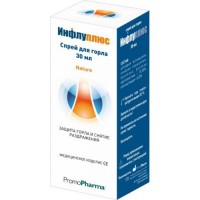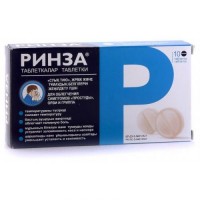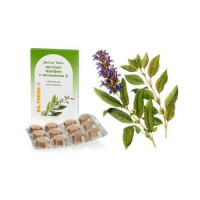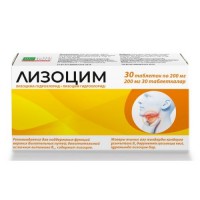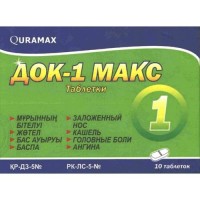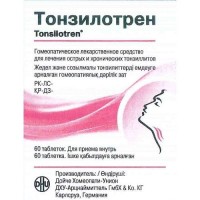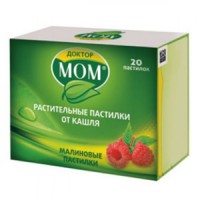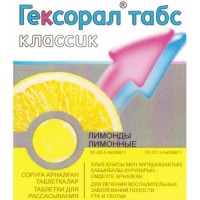Trade name
of Flyukol-S
the International unlicensed name
Is not present
the Dosage form
of the Tablet, film coated
Structure
One tablet contains
active agents: paracetamol of 500 mg
of Phenylephrinum of a hydrochloride of 5 mg
caffeine of 25 mg
of terpin hydrate of 20 mg
of ascorbic acid of 30 mg,
excipients: gelatin, starch corn, the talc purified of magnesium stearate, sodium of starch glikolit,
structure of a cover: yellow sunset (E110), K 30 polyvinylpirrolidone, titan dioxide (E 171), dinatrium edetat, ethyl cellulose, potassium sorbate.
The description
Round biconvex tablets, film coated orange color with marbling, a kernel of light orange color with vkrapkleniye of orange and white color.
The pharmacotherapeutic
Paracetamol group in a combination with other drugs (excepting psikholeptik)
N02BE51
the Pharmacological
Pharmacokinetics Paracetamol At properties intake is quickly absorbed from digestive tract. In a human body the ratio between paracetamol level in whole blood and plasma is close to 1. In saliva drug comes to light in the concentration correlating with paracetamol content in plasma. The maximum level in blood plasma is reached in 30-60 min. Paracetamol is quickly and evenly distributed on body tissues. The ability of paracetamol to get into brain fabric where it is evenly distributed is high. The exception makes a hypophysis in which the content of drug is 2-3 times higher, than in other structures of a brain. At the same time paracetamol is quicker removed from brain fabric, than salicylates. Less long febrifugal effect of drug in comparison with aspirin is connected with it. In mother's milk the content of paracetamol does not exceed 1%. After prescribing of paracetamol in a dose of 10-15 mg/kg the medical effect coming usually in 30 min. lasts for 2-4 h.
Linking with proteins of blood plasma makes 80-15% of the accepted dose. Distribution volume sizes at children and adults significantly do not differ. Drug breaks a placental barrier.
Elimination happens generally by biotransformation in a liver - up to 90-95% of the accepted dose. Paracetamol is metabolized by microsomal enzymes of a liver. About 80% form conjugates with glucuronic acid and sulfates, up to 17% is exposed to hydroxylation with formation of active metabolites which conjugate with glutathione. At overdose or a lack of glutathione these metabolites can cause necrosis of hepatocytes. There are qualitative changes of metabolism of paracetamol depending on age of the child. At newborns and children up to 10-12 years the formation of pair ethers with sulphuric acid (sulfates), at the senior children (after 12 years) and adults prevails - with glucuronic acid (glucuronides). The formed metabolites and paracetamol at newborns are removed by kidneys more slowly (2.65-4.35 h), than at adults (1.9-2.2 h). Repeated and uncontrollable administration of drug to the newborn can lead to cumulation it in an organism. The delay of removal of paracetamol and its metabolites is observed at disturbance of renal function and at patients with chronic diseases of a liver.
The half-cycle of removal from an organism makes 1.5-2 h. It can increase at patients with the profound renal failures, a liver and elderly patients. In 24 hours of 85-90% of a dose 3% in not changed look are removed with urine in the form of glucuronides and sulfates, and. Probability of gepatoksichesky effect at children is lower, than at adults. Other pharmacokinetic effects at adults and children do not differ.
Caffeine
After intake is quickly and completely soaked up from intestines (including from a large intestine). The maximum is reached in 5-90 min. after reception on an empty stomach. It is distributed on bodies and fabrics, including central nervous system, embryonic fabrics and breast milk.
The main part of caffeine demetilirutsya and oxidized. About 10% of drug are removed with urine in not changed look.
Terpin hydrate
is Quickly soaked up from a GIT after intake. Drug circulates in blood in not changed look and is removed through airways, with urine and then to which it gives a specific smell. A part of drug is exposed in an organism to oxidation and is removed with urine in the form of phenols together with glucuronic acid.
It is partially excreted by bronchial glands, stimulates their secretion and increases products of a liquid component of a phlegm a little, thereby, facilitating its discharge. At intake it is soaked up in blood, allocated with glands of a bronchial tree, at the same time increasing their secretion. Positively works in small doses (up to 0.5 g), high doses (up to 3.0 g a day) reduce department of a liquid phlegm.
Phenylephrinum a hydrochloride
After intake Phenylephrinum is badly soaked up from a GIT. It is metabolized with the participation of a monoaminooxidase (MAO) in a wall of intestines and at 'the first passing' through a liver. Bioavailability of Phenylephrinum low. After topical administration is exposed to system absorption.
Ascorbic acid
is Well soaked up in digestive tract and easily distributed in body tissues. The biocomprehensibility is about 70%. Plasma concentration of ascorbic acid increases at intake of substance in digestive tract up to the certain size. It occurs at daily administration of drug in a dose of 90 - 150 mg daily. Reserves of ascorbic acid in an organism at the healthy person make 1.5 g. Biotransformation of ascorbic acid occurs in a liver. It reversibly is oxidized to dehydroascorbic acid, are partially metabolized to the ascorbate-2-sulfate which is neutral and oxalic acid which are allocated with urine. Ascorbic acid in the dose exceeding requirement of an organism eliminirutsya quickly with urine. Pathology of digestive tract interferes with digestion of ascorbic acid.
The pharmacodynamics
Paracetamol well gets through a blood-brain barrier. Its central soothing and febrifugal action by means of reduction of threshold level of these processes, by impact on the centers of thermal control and pain in a hypothalamus by prostaglandinsintetaza enzyme blockade is connected with it that interferes with synthesis of prostaglandins. It eliminates their impact on the centers of thermal control leading to decrease in body temperature. Loss of heat a body at feverish states increases in result of vasodilatation and increase in resilience of a peripheral blood-groove. Besides, the soothing effect of paracetamol is connected with peripheral blocking of impulses on the bradikininchuvstvitelny chemoceptors responsible for developing of pain. Owing to an acute inflammation there is a microcirculation disturbance, first of all microcirculation. It leads to change of sensitivity of the pain receptors which are located on the course of blood vessels.
The febrifugal effect of paracetamol, as well as other non-steroidal anti-inflammatory drugs, consists in decrease in feverish, but not normal body temperature.
In the inflamed fabrics cellular peroxidases neutralize influence of paracetamol on cyclooxygenase that explains almost full lack of anti-inflammatory action.
Caffeine - a psychostimulant and an analeptic. Stimulates the respiratory and vasomotor centers of a brain, weakens action of the means oppressing the central nervous system (CNS), increases physical and intellectual effeciency, reduces drowsiness and feeling of fatigue. Caffeine increases arterial blood pressure in arterial hypotension, increases heart rate. In small degree raises a diuresis.
Terpin hydrate has expectorant effect, increases secretory function of epithelial glands of airways, increases the volume of secretion and lowers viscosity of the allocated secret.
Phenylephrinum hydrochloride. Adrenomimetik. Has direct promoting effect mainly on α-adrenoceptors. At system use causes narrowing of arterioles, increases the arterial blood pressure (ABP). Warm emission does not change or decreases that is connected with reflex bradycardia (increase in a tone of vagus nerve) in response to arterial hypertension. In average therapeutic doses practically does not influence central nervous system.
Ascorbic acid (Vitamin C) takes part in many types of redoxreactions in an organism. The major representatives are L-ascorbic acid and its oxidized form - dehydroascorbic acid. The main property of the specified connections – antioxidant. Ascorbic acid slows down processes of peroxide oxidation of lipids, proteins and other components of a cell, than protects it from damage. Vitamin C increases concentration of interferon in blood. The membrane stabilizing effect of vitamin C and its immunomodulatory action is connected with it. Vitamin C is capable to collect in leukocytes, increasing their phagocytal activity that increases antimicrobial and antiviral protection. Ascorbic acid activates biosynthesis of hormones in bark of adrenal glands and by that stimulates adaptive processes of an organism in stresses.
At deficiency of vitamin C the risk of developing catarrhal diseases increases, cholesterol level in blood increases, bleeding of gums, increased fatigue and so forth develops.
Indications
- elimination of symptoms of a SARS and flu (a fever, temperature increase, a headache, a joint pain and muscles, congestion of a nose, cough)
Apply the Route of administration and doses inside. The adult 1 tablet 3 - 4 times a day. A course of treatment at use as febrifugal and analgetic means no more than three days.
Side effects
- hypersensitivity to any of drug components (skin rash, an itching of skin, a small tortoiseshell, a Quincke's edema, Stephens-Johnson's syndrome, a Lyell's disease, it is rare - an acute anaphylaxis)
- a renal failure
- dryness in a mouth, nausea, vomiting, pains in epigastriums, stomach spasms, irritation of a mucous membrane of digestive tract, diarrhea, a constipation
- hepatotoxic action
- thrombocytopenia, a leukopenia, an agranulocytosis, the hemolytic anemia connected with deficit glyukozo-6-fosfatdegidrogenazy, thrombosis
- a headache, feeling of fatigue, at prolonged use of high doses – increase in excitability of central nervous system, a sleep disorder, insomnia, a disorientation in time and space, concern, a delirium, deterioration in short-term memory, easing of attention
- at children perhaps paradoxical development of insomnia, irritability and euphoria, ambiguity of sight
- a hyperglycemia, a glucosuria
- decrease in permeability of capillaries and deterioration in a trophicity of fabrics
- the increased viscosity of secretion of respiratory tract
- reduced sweating in combination with the increased body temperature
- sexual dysfunction
- tachycardia, arrhythmia, increase in arterial blood pressure
- at use in high doses – a hyperoxaluria, formation of oxalic urinary stones, damage of the glomerular device of kidneys
of the Contraindication
- the increased individual sensitivity to drug components
- a peptic ulcer of a stomach and duodenum
- gastrointestinal bleedings
- the profound abnormal liver functions or kidneys
- blood diseases with tendency to hemorrhages
- pregnancy and the period of a lactation
- children's and teenage age up to 18 years
- arterial hypertension
- atherosclerosis
- glaucoma
- hyperexcitability, sleep disorders
- a concomitant use of tricyclic antidepressants, MAO inhibitors, beta blockers
- deficit glyukozo-6-fosfatdegidrogenazy
Medicinal interactions
Paracetamol. Probenetsid, the isoniazid, Cimetidinum, ranitidine, propranolol, increase elimination half-life and reduce clearance of paracetamol. At use together with the drugs causing induction of enzymes of a liver (Salicylamidum, barbiturates, antiepileptic drugs, tricyclic antidepressants, alcohol, rifampicin) the level of toxic metabolites of paracetamol increases. At use along with chloramphenicol the elimination half-life of the last increases and its toxicity increases. At simultaneous use with oral anticoagulants the prothrombin time is extended, the danger of bleedings increases. Simultaneous use with doxorubicine increases risk of an abnormal liver function. Metoclopramidum and domperidon strengthen paracetamol absorption, and holestiramin reduces it.
Caffeine reduces effect of hypnotic drugs and drugs. Caffeine increases effect of acetylsalicylic acid, paracetamol and other non-narcotic analgesics (improving their bioavailability). Caffeine improves absorption of ergotamine in a GIT.
Ascorbic acid increases concentration in blood of benzylpenicillin and tetracyclines, in a dose of 1 g/days increases bioavailability of ethinylestradiol (including being a part of oral contraceptives). Improves absorption in intestines of iron preparations (transfers trivalent iron to bivalent), can increase removal of iron at simultaneous use with Deferoxaminum.
Reduces efficiency of heparin and indirect anticoagulants.
Acetylsalicylic acid (ASK), oral contraceptives, fresh juice and alkaline drink reduce absorption and digestion of ascorbic acid. At simultaneous use with ASK the removal with urine of ascorbic acid increases and removal of ASK decreases. ASK reduces absorption of ascorbic acid approximately by 30%.
Increases risk of development of a crystalluria at treatment by salicylates and streptocides of short action, slows down removal by kidneys of acids, increases removal of the drugs having alkali reaction (including alkaloids), reduces concentration in blood of oral contraceptives.
Increases the general clearance of ethanol which, in turn, reduces concentration of ascorbic acid in an organism.
Drugs of a quinolinic row, Calcii chloridum, salicylates, glucocorticosteroids at prolonged use exhaust reserves of ascorbic acid.
At simultaneous use reduces chronotropic action of an izoprenalin.
At prolonged use or use in high doses Disulfiramum-ethanol can break interaction.
In high doses increases removal of a meksiletin kidneys.
Barbiturates and Primidonum increase removal of ascorbic acid with urine. Reduces therapeutic effect of antipsychotic medicines (neuroleptics) - derivatives of a fenotiazin, a canalicular reasorbtion of amphetamine and tricyclic antidepressants.
Phenylephrinum the hydrochloride along with furasolidone can lead to hypertensive crisis, excitement, a hyper pyrexia. Tricyclic antidepressants strengthen adrenomimetichesky effect of Phenylephrinum, co-administration of a halothane increases risk of developing ventricular arrhythmia. Reduces hypotensive action of a guanetidin who, in turn, enhances alpha adrenostimuliruyushchuyu activity of Phenylephrinum.
At use of Phenylephrinum against the background of the general anesthesia caused by a halothane or cyclopropane the development of ventricular fibrillation is possible.
At simultaneous use with MAO inhibitors the potentiation of effects of Phenylephrinum (is observed including at topical administration).
Fenotiazina, alpha adrenoblockers (phentolamine), furosemide and other diuretics reduce vasopressor effect of Phenylephrinum.
Guanetidin enhances mydriatic effect of Phenylephrinum (at system absorption).
Oxytocin, ergot alkaloids, tricyclic antidepressants, furasolidone, Procarbazinum, selegilin, sympathomimetics enhance pressor effect, and the last - and an aritmogennost.
At simultaneous use, beta blockers reduce the cardiostimulating activity, against the background of reserpine the arterial hypertension (owing to exhaustion of stocks of catecholamines in adrenergic neurons the sensitivity to sympathomimetics increases) is possible.
The special
instructions Paracetamol care are appointed in chronic diseases of a liver and kidneys, gout, a peptic ulcer of a stomach and a duodenum (in the anamnesis). It is necessary to consider degree and the nature of functional changes of data of bodies as at these patients the increase in time of semi-removal of paracetamol is possible. Intake of paracetamol can affect results of definition of uric acid in blood by means of phosphatotungstic acid and determination of level of a glycemia by method glyukozo - oxidases-peroxidases. At administration of drug and during manifestation of its action the consumption of alcoholic beverages is forbidden.
It is necessary to report about all side (unusual) effects including which are not stated above to the attending physician. In the absence of improvement of health administration of drug it is necessary to stop and see a doctor. If surgical intervention is necessary to the patient, he has to warn the doctor about administration of drug in advance.
In relation to caffeine the individual sensitivity is shown therefore Flukoldex Forte's appointment has to be carried out taking into account specific features of nervous activity.
At prolonged use of caffeine perhaps weak accustoming (decrease in effect of caffeine is connected with education in cells of a brain of new adenosine receptors).
The termination of administration of drug can cause braking of central nervous system with emergence of feeling of exhaustion, drowsiness and a depression.
Features of influence on ability to run the vehicle or potentially dangerous mechanisms
Considering side effects of drug (a headache, easing of attention, a disorientation in time and space) it is necessary to refrain from driving and potentially dangerous mechanisms.
Overdose
Symptoms: nausea, vomiting, abdominal pain, perspiration, pallor of integuments, tachycardia, increase in arterial blood pressure. In slight intoxications a ring in ears. Heavy intoxication - drowsiness, spasms, an anury, bleedings, the progressing breath paralysis, respiratory acidosis.
At suspicion of poisoning it is necessary to ask for medical assistance immediately.
Treatment: gastric lavage, intake of salt laxative, activated carbon with the subsequent prescribing of N-Acetylcysteinum or methionine inside, carrying out an artificial diuresis, a hemodialysis, at development of a convulsive syndrome - intravenous administration of anticonvulsant drugs. This therapy is carried out in toxicological department.
Antidote in poisoning with paracetamol - Acetylcysteinum. Exhaustion warns and promotes increase in synthesis of the intracellular glutathione participating in oxidation-reduction processes of cells, thus, promoting a detoxication of hazardous substances.
The overdose by caffeine is almost impossible because of its low content in drug.
A form of release and packing
of Tablet No. 12 in blister strip packaging. On 1 blister strip packaging in a cardboard pack together with the instruction for use in the state and Russian languages.
Storage conditions
In the place protected from light, at a temperature not above +25os.
To store out of children's reach!
A period of storage
3 years
not to apply after an expiration date
Prescription status
Without prescription
to Develop
of Flyukol-S
the International unlicensed name
Is not present
the Dosage form
of the Tablet, film coated
Structure
One tablet contains
active agents: paracetamol of 500 mg
of Phenylephrinum of a hydrochloride of 5 mg
caffeine of 25 mg
of terpin hydrate of 20 mg
of ascorbic acid of 30 mg,
excipients: gelatin, starch corn, the talc purified of magnesium stearate, sodium of starch glikolit,
structure of a cover: yellow sunset (E110), K 30 polyvinylpirrolidone, titan dioxide (E 171), dinatrium edetat, ethyl cellulose, potassium sorbate.
The description
Round biconvex tablets, film coated orange color with marbling, a kernel of light orange color with vkrapkleniye of orange and white color.
The pharmacotherapeutic
Paracetamol group in a combination with other drugs (excepting psikholeptik)
N02BE51
the Pharmacological
Pharmacokinetics Paracetamol At properties intake is quickly absorbed from digestive tract. In a human body the ratio between paracetamol level in whole blood and plasma is close to 1. In saliva drug comes to light in the concentration correlating with paracetamol content in plasma. The maximum level in blood plasma is reached in 30-60 min. Paracetamol is quickly and evenly distributed on body tissues. The ability of paracetamol to get into brain fabric where it is evenly distributed is high. The exception makes a hypophysis in which the content of drug is 2-3 times higher, than in other structures of a brain. At the same time paracetamol is quicker removed from brain fabric, than salicylates. Less long febrifugal effect of drug in comparison with aspirin is connected with it. In mother's milk the content of paracetamol does not exceed 1%. After prescribing of paracetamol in a dose of 10-15 mg/kg the medical effect coming usually in 30 min. lasts for 2-4 h.
Linking with proteins of blood plasma makes 80-15% of the accepted dose. Distribution volume sizes at children and adults significantly do not differ. Drug breaks a placental barrier.
Elimination happens generally by biotransformation in a liver - up to 90-95% of the accepted dose. Paracetamol is metabolized by microsomal enzymes of a liver. About 80% form conjugates with glucuronic acid and sulfates, up to 17% is exposed to hydroxylation with formation of active metabolites which conjugate with glutathione. At overdose or a lack of glutathione these metabolites can cause necrosis of hepatocytes. There are qualitative changes of metabolism of paracetamol depending on age of the child. At newborns and children up to 10-12 years the formation of pair ethers with sulphuric acid (sulfates), at the senior children (after 12 years) and adults prevails - with glucuronic acid (glucuronides). The formed metabolites and paracetamol at newborns are removed by kidneys more slowly (2.65-4.35 h), than at adults (1.9-2.2 h). Repeated and uncontrollable administration of drug to the newborn can lead to cumulation it in an organism. The delay of removal of paracetamol and its metabolites is observed at disturbance of renal function and at patients with chronic diseases of a liver.
The half-cycle of removal from an organism makes 1.5-2 h. It can increase at patients with the profound renal failures, a liver and elderly patients. In 24 hours of 85-90% of a dose 3% in not changed look are removed with urine in the form of glucuronides and sulfates, and. Probability of gepatoksichesky effect at children is lower, than at adults. Other pharmacokinetic effects at adults and children do not differ.
Caffeine
After intake is quickly and completely soaked up from intestines (including from a large intestine). The maximum is reached in 5-90 min. after reception on an empty stomach. It is distributed on bodies and fabrics, including central nervous system, embryonic fabrics and breast milk.
The main part of caffeine demetilirutsya and oxidized. About 10% of drug are removed with urine in not changed look.
Terpin hydrate
is Quickly soaked up from a GIT after intake. Drug circulates in blood in not changed look and is removed through airways, with urine and then to which it gives a specific smell. A part of drug is exposed in an organism to oxidation and is removed with urine in the form of phenols together with glucuronic acid.
It is partially excreted by bronchial glands, stimulates their secretion and increases products of a liquid component of a phlegm a little, thereby, facilitating its discharge. At intake it is soaked up in blood, allocated with glands of a bronchial tree, at the same time increasing their secretion. Positively works in small doses (up to 0.5 g), high doses (up to 3.0 g a day) reduce department of a liquid phlegm.
Phenylephrinum a hydrochloride
After intake Phenylephrinum is badly soaked up from a GIT. It is metabolized with the participation of a monoaminooxidase (MAO) in a wall of intestines and at 'the first passing' through a liver. Bioavailability of Phenylephrinum low. After topical administration is exposed to system absorption.
Ascorbic acid
is Well soaked up in digestive tract and easily distributed in body tissues. The biocomprehensibility is about 70%. Plasma concentration of ascorbic acid increases at intake of substance in digestive tract up to the certain size. It occurs at daily administration of drug in a dose of 90 - 150 mg daily. Reserves of ascorbic acid in an organism at the healthy person make 1.5 g. Biotransformation of ascorbic acid occurs in a liver. It reversibly is oxidized to dehydroascorbic acid, are partially metabolized to the ascorbate-2-sulfate which is neutral and oxalic acid which are allocated with urine. Ascorbic acid in the dose exceeding requirement of an organism eliminirutsya quickly with urine. Pathology of digestive tract interferes with digestion of ascorbic acid.
The pharmacodynamics
Paracetamol well gets through a blood-brain barrier. Its central soothing and febrifugal action by means of reduction of threshold level of these processes, by impact on the centers of thermal control and pain in a hypothalamus by prostaglandinsintetaza enzyme blockade is connected with it that interferes with synthesis of prostaglandins. It eliminates their impact on the centers of thermal control leading to decrease in body temperature. Loss of heat a body at feverish states increases in result of vasodilatation and increase in resilience of a peripheral blood-groove. Besides, the soothing effect of paracetamol is connected with peripheral blocking of impulses on the bradikininchuvstvitelny chemoceptors responsible for developing of pain. Owing to an acute inflammation there is a microcirculation disturbance, first of all microcirculation. It leads to change of sensitivity of the pain receptors which are located on the course of blood vessels.
The febrifugal effect of paracetamol, as well as other non-steroidal anti-inflammatory drugs, consists in decrease in feverish, but not normal body temperature.
In the inflamed fabrics cellular peroxidases neutralize influence of paracetamol on cyclooxygenase that explains almost full lack of anti-inflammatory action.
Caffeine - a psychostimulant and an analeptic. Stimulates the respiratory and vasomotor centers of a brain, weakens action of the means oppressing the central nervous system (CNS), increases physical and intellectual effeciency, reduces drowsiness and feeling of fatigue. Caffeine increases arterial blood pressure in arterial hypotension, increases heart rate. In small degree raises a diuresis.
Terpin hydrate has expectorant effect, increases secretory function of epithelial glands of airways, increases the volume of secretion and lowers viscosity of the allocated secret.
Phenylephrinum hydrochloride. Adrenomimetik. Has direct promoting effect mainly on α-adrenoceptors. At system use causes narrowing of arterioles, increases the arterial blood pressure (ABP). Warm emission does not change or decreases that is connected with reflex bradycardia (increase in a tone of vagus nerve) in response to arterial hypertension. In average therapeutic doses practically does not influence central nervous system.
Ascorbic acid (Vitamin C) takes part in many types of redoxreactions in an organism. The major representatives are L-ascorbic acid and its oxidized form - dehydroascorbic acid. The main property of the specified connections – antioxidant. Ascorbic acid slows down processes of peroxide oxidation of lipids, proteins and other components of a cell, than protects it from damage. Vitamin C increases concentration of interferon in blood. The membrane stabilizing effect of vitamin C and its immunomodulatory action is connected with it. Vitamin C is capable to collect in leukocytes, increasing their phagocytal activity that increases antimicrobial and antiviral protection. Ascorbic acid activates biosynthesis of hormones in bark of adrenal glands and by that stimulates adaptive processes of an organism in stresses.
At deficiency of vitamin C the risk of developing catarrhal diseases increases, cholesterol level in blood increases, bleeding of gums, increased fatigue and so forth develops.
Indications
- elimination of symptoms of a SARS and flu (a fever, temperature increase, a headache, a joint pain and muscles, congestion of a nose, cough)
Apply the Route of administration and doses inside. The adult 1 tablet 3 - 4 times a day. A course of treatment at use as febrifugal and analgetic means no more than three days.
Side effects
- hypersensitivity to any of drug components (skin rash, an itching of skin, a small tortoiseshell, a Quincke's edema, Stephens-Johnson's syndrome, a Lyell's disease, it is rare - an acute anaphylaxis)
- a renal failure
- dryness in a mouth, nausea, vomiting, pains in epigastriums, stomach spasms, irritation of a mucous membrane of digestive tract, diarrhea, a constipation
- hepatotoxic action
- thrombocytopenia, a leukopenia, an agranulocytosis, the hemolytic anemia connected with deficit glyukozo-6-fosfatdegidrogenazy, thrombosis
- a headache, feeling of fatigue, at prolonged use of high doses – increase in excitability of central nervous system, a sleep disorder, insomnia, a disorientation in time and space, concern, a delirium, deterioration in short-term memory, easing of attention
- at children perhaps paradoxical development of insomnia, irritability and euphoria, ambiguity of sight
- a hyperglycemia, a glucosuria
- decrease in permeability of capillaries and deterioration in a trophicity of fabrics
- the increased viscosity of secretion of respiratory tract
- reduced sweating in combination with the increased body temperature
- sexual dysfunction
- tachycardia, arrhythmia, increase in arterial blood pressure
- at use in high doses – a hyperoxaluria, formation of oxalic urinary stones, damage of the glomerular device of kidneys
of the Contraindication
- the increased individual sensitivity to drug components
- a peptic ulcer of a stomach and duodenum
- gastrointestinal bleedings
- the profound abnormal liver functions or kidneys
- blood diseases with tendency to hemorrhages
- pregnancy and the period of a lactation
- children's and teenage age up to 18 years
- arterial hypertension
- atherosclerosis
- glaucoma
- hyperexcitability, sleep disorders
- a concomitant use of tricyclic antidepressants, MAO inhibitors, beta blockers
- deficit glyukozo-6-fosfatdegidrogenazy
Medicinal interactions
Paracetamol. Probenetsid, the isoniazid, Cimetidinum, ranitidine, propranolol, increase elimination half-life and reduce clearance of paracetamol. At use together with the drugs causing induction of enzymes of a liver (Salicylamidum, barbiturates, antiepileptic drugs, tricyclic antidepressants, alcohol, rifampicin) the level of toxic metabolites of paracetamol increases. At use along with chloramphenicol the elimination half-life of the last increases and its toxicity increases. At simultaneous use with oral anticoagulants the prothrombin time is extended, the danger of bleedings increases. Simultaneous use with doxorubicine increases risk of an abnormal liver function. Metoclopramidum and domperidon strengthen paracetamol absorption, and holestiramin reduces it.
Caffeine reduces effect of hypnotic drugs and drugs. Caffeine increases effect of acetylsalicylic acid, paracetamol and other non-narcotic analgesics (improving their bioavailability). Caffeine improves absorption of ergotamine in a GIT.
Ascorbic acid increases concentration in blood of benzylpenicillin and tetracyclines, in a dose of 1 g/days increases bioavailability of ethinylestradiol (including being a part of oral contraceptives). Improves absorption in intestines of iron preparations (transfers trivalent iron to bivalent), can increase removal of iron at simultaneous use with Deferoxaminum.
Reduces efficiency of heparin and indirect anticoagulants.
Acetylsalicylic acid (ASK), oral contraceptives, fresh juice and alkaline drink reduce absorption and digestion of ascorbic acid. At simultaneous use with ASK the removal with urine of ascorbic acid increases and removal of ASK decreases. ASK reduces absorption of ascorbic acid approximately by 30%.
Increases risk of development of a crystalluria at treatment by salicylates and streptocides of short action, slows down removal by kidneys of acids, increases removal of the drugs having alkali reaction (including alkaloids), reduces concentration in blood of oral contraceptives.
Increases the general clearance of ethanol which, in turn, reduces concentration of ascorbic acid in an organism.
Drugs of a quinolinic row, Calcii chloridum, salicylates, glucocorticosteroids at prolonged use exhaust reserves of ascorbic acid.
At simultaneous use reduces chronotropic action of an izoprenalin.
At prolonged use or use in high doses Disulfiramum-ethanol can break interaction.
In high doses increases removal of a meksiletin kidneys.
Barbiturates and Primidonum increase removal of ascorbic acid with urine. Reduces therapeutic effect of antipsychotic medicines (neuroleptics) - derivatives of a fenotiazin, a canalicular reasorbtion of amphetamine and tricyclic antidepressants.
Phenylephrinum the hydrochloride along with furasolidone can lead to hypertensive crisis, excitement, a hyper pyrexia. Tricyclic antidepressants strengthen adrenomimetichesky effect of Phenylephrinum, co-administration of a halothane increases risk of developing ventricular arrhythmia. Reduces hypotensive action of a guanetidin who, in turn, enhances alpha adrenostimuliruyushchuyu activity of Phenylephrinum.
At use of Phenylephrinum against the background of the general anesthesia caused by a halothane or cyclopropane the development of ventricular fibrillation is possible.
At simultaneous use with MAO inhibitors the potentiation of effects of Phenylephrinum (is observed including at topical administration).
Fenotiazina, alpha adrenoblockers (phentolamine), furosemide and other diuretics reduce vasopressor effect of Phenylephrinum.
Guanetidin enhances mydriatic effect of Phenylephrinum (at system absorption).
Oxytocin, ergot alkaloids, tricyclic antidepressants, furasolidone, Procarbazinum, selegilin, sympathomimetics enhance pressor effect, and the last - and an aritmogennost.
At simultaneous use, beta blockers reduce the cardiostimulating activity, against the background of reserpine the arterial hypertension (owing to exhaustion of stocks of catecholamines in adrenergic neurons the sensitivity to sympathomimetics increases) is possible.
The special
instructions Paracetamol care are appointed in chronic diseases of a liver and kidneys, gout, a peptic ulcer of a stomach and a duodenum (in the anamnesis). It is necessary to consider degree and the nature of functional changes of data of bodies as at these patients the increase in time of semi-removal of paracetamol is possible. Intake of paracetamol can affect results of definition of uric acid in blood by means of phosphatotungstic acid and determination of level of a glycemia by method glyukozo - oxidases-peroxidases. At administration of drug and during manifestation of its action the consumption of alcoholic beverages is forbidden.
It is necessary to report about all side (unusual) effects including which are not stated above to the attending physician. In the absence of improvement of health administration of drug it is necessary to stop and see a doctor. If surgical intervention is necessary to the patient, he has to warn the doctor about administration of drug in advance.
In relation to caffeine the individual sensitivity is shown therefore Flukoldex Forte's appointment has to be carried out taking into account specific features of nervous activity.
At prolonged use of caffeine perhaps weak accustoming (decrease in effect of caffeine is connected with education in cells of a brain of new adenosine receptors).
The termination of administration of drug can cause braking of central nervous system with emergence of feeling of exhaustion, drowsiness and a depression.
Features of influence on ability to run the vehicle or potentially dangerous mechanisms
Considering side effects of drug (a headache, easing of attention, a disorientation in time and space) it is necessary to refrain from driving and potentially dangerous mechanisms.
Overdose
Symptoms: nausea, vomiting, abdominal pain, perspiration, pallor of integuments, tachycardia, increase in arterial blood pressure. In slight intoxications a ring in ears. Heavy intoxication - drowsiness, spasms, an anury, bleedings, the progressing breath paralysis, respiratory acidosis.
At suspicion of poisoning it is necessary to ask for medical assistance immediately.
Treatment: gastric lavage, intake of salt laxative, activated carbon with the subsequent prescribing of N-Acetylcysteinum or methionine inside, carrying out an artificial diuresis, a hemodialysis, at development of a convulsive syndrome - intravenous administration of anticonvulsant drugs. This therapy is carried out in toxicological department.
Antidote in poisoning with paracetamol - Acetylcysteinum. Exhaustion warns and promotes increase in synthesis of the intracellular glutathione participating in oxidation-reduction processes of cells, thus, promoting a detoxication of hazardous substances.
The overdose by caffeine is almost impossible because of its low content in drug.
A form of release and packing
of Tablet No. 12 in blister strip packaging. On 1 blister strip packaging in a cardboard pack together with the instruction for use in the state and Russian languages.
Storage conditions
In the place protected from light, at a temperature not above +25os.
To store out of children's reach!
A period of storage
3 years
not to apply after an expiration date
Prescription status
Without prescription
to Develop

